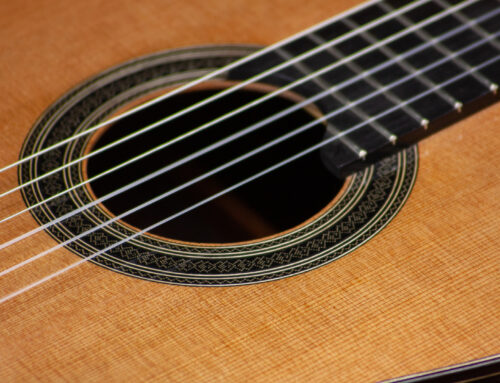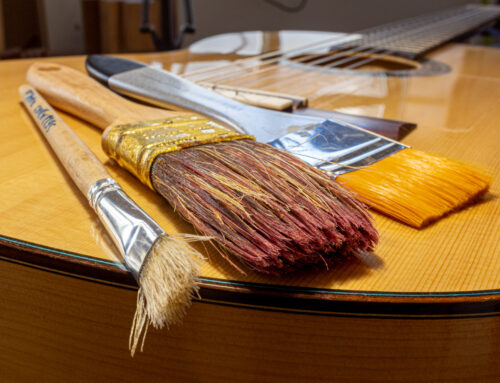An interesting topic in the guitar world is to understand how the instrument works from a physical-acoustic point of view. That is, when we hear a guitar, what is going on, what parts of the instrument make up let’s say “the voice” of the instrument? As almost everything in this blog, I don’t pretend to give an exhaustive answer, nor will I go into very complex physical questions, since as a luthier they are completely beyond me, and besides they can be a bit boring for a general audience.
Physical-acoustic behavior of the guitar
I’m sure you’ve done the experiment, and if not, I encourage you to do so. Take a string, it can be an old string from your guitar or any string you find around the house. Good. Now ask someone to grab it by the ends and stretch it as much as they can with their hands. Finally, pluck it, as if it were a guitar string. You will see that a vibration is generated: the string starts to oscillate from one side to the other until it returns to its initial resting point.
So far so good, but you may have noticed that the vibration generated is barely audible. What would it take to make it louder? Indeed: a sounding board. You can do the same experiment by bringing the string close to a shoebox, and you will see that the sound increases noticeably in volume.
A classical or acoustic guitar sounds thanks to the transmission of the vibrations from the strings to the soundboard through the bridge.
So, a soundboard is basically an amplifier of the vibration generated by the string when vibrating. This behavior can be extrapolated to a large extent to that of any acoustic stringed instrument, such as the violin or the piano. But the summary of the story is as follows: a classical or acoustic guitar sounds thanks to the transmission of vibrations from the strings to the soundboard, through the bridge. These vibrations travel through the soundboard and bounce back out, mostly through the soundhole. And that’s it.
Influence of the soundboard on the guitar sound
The soundboard is the most acoustically and physically active part of a guitar. Connected to the strings through the bridge, when a string is plucked, the soundboard starts to vibrate. You can test it on your guitar, very simply. Press a string and then put your fingers on the top: you will see that there is a lot of activity. That the soundboard moves. Somehow, the soundboard “pumps” the vibrations into the soundboard, which is responsible for returning them to the outside through the soundhole.
The soundboard is made of a soft wood, such as spruce or cedar, so that it is a flexible material that can vibrate widely. If we were to put a very dense wood on the top of a guitar, it would probably sound less and with much less balance between treble and bass.
So, basically, what we are hearing when we listen to a guitar is the vibration of the strings and the soundboard. This is what mainly makes up the sound of the instrument. This is the opinion of many guitarists, among whom we must mention -once again- the great Antonio de Torres, who argued that the sound of the guitar depended mainly on the soundboard and its bracing, as I explained in this post.

Guitar bridge transmits the vibration of the strings to the soundboard
A well made soundboard gives us a nuanced sound.
Actually, what the soundboard does is to respond to the vibration of the strings. That is to say that, a bit contrary to what I said, the soundboard is not an active element in the sound generation process, but it is a reaction to the oscillating movement of the strings. In this process, of course, it influences what material and tension the strings are made of.
But the point is that a soundboard will be all the better the better it amplifies all the waves that the strings are producing. In other words, the more sensitive it is to these vibrations, without giving predominance to some frequencies over others. It is said that this way a guitar is well balanced. If the top of a guitar is not properly worked, or the density of the wood used to build it is not adequate, the reaction to the movement of the strings will be poor, or too dirty, or with little power… In other words: it is a bad guitar.
A guitar will be better the more sensitive its top is to the vibrations generated by the strings.
So, if the soundboard does not react to the guitarist’s impulses, or requires a great effort from the guitarist, we are faced with a guitar of poor quality, with an unballanced sound without nuances. If we think about it, this is something that happens with many things in our daily life. We can drink a cheap wine -the kind that comes in a cardboard box- and yes, we will be drinking wine. No one disputes that, in principle. But if we compare it with a quality wine, what the latter will give us are many more nuances in the taste, in the aroma? This is what many call the “personality” of the wine. The same can be said of the guitar. If the sound has nuances, then there is quality.
Another very different thing is whether we like the sound of a guitar more or less. Or that it is useful or not for a certain repertoire. But that is a subject that exceeds the content of this post.






Leave A Comment